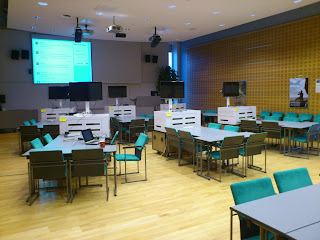I have been working as a change agent now for a while and one question that I pump into from time to time is: "How about the non-motivated part of our people?". The curious thing is, that most of these people were enthusiastic students. The working life is the one that has killed the passion.
So why is that? In a natural way, people are organising themselves into a dynamic network. I wrote a blog post about this. Workplaces are forcing people to form unnatural constructions and the agony which is caused by this is the one which starts to eat the motivation of people.
As long as we are not going to fix this, we are only dealing with symptoms. By fixing symptoms nothing magnificent will happen.
ps. With the Nine-to-Five, I mean second definition from here: http://www.yourdictionary.com/nine-to-five
| Cubicles in a now-defunct co-working space in Portland, Oregon. CubeSpace 2009-05-20 20:30 By Asa Wilson |
As long as we are not going to fix this, we are only dealing with symptoms. By fixing symptoms nothing magnificent will happen.
ps. With the Nine-to-Five, I mean second definition from here: http://www.yourdictionary.com/nine-to-five




